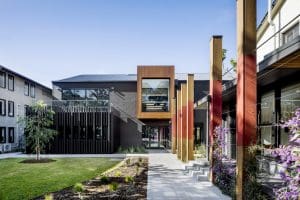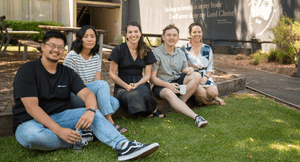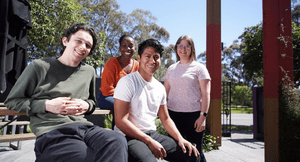An Educational Fiction
 Andrew Malone writes
Andrew Malone writes
My kids love The Roman Mysteries. They spent the holidays rereading the series. Freshly released electronically, the seventeen novels fit the ‘young tween sleuths’ genre, much like the Famous Five. But instead of exploring the moors and crags of twentieth-century Britain, our intrepid investigators solve the minor and major puzzles besetting the Roman empire in a.d. 79–81.
I love the series too. The stories are so engaging that the BBC has filmed ten of them with good production values and some famous actors. Moreover author Caroline Lawrence, a trained classicist, has done her homework; each fictional adventure is accurately framed within the history, culture and geography of the day. Thus my kids (and I) are introduced to powerful-but-beneficent Emperor Titus (and his more ambitious and indulgent brother, Domitian). Famous scholar and admiral Pliny the Elder is overwhelmed by the fumes when Mount Vesuvius erupts, and his mantle passes to his sprightly adopted nephew, Pliny the Younger. Gladiators, merchants and assassins abound; so does relevant mention of foods, writing practices, seafaring, mythology, patronage, oratory, farming, slavery and toilet sticks! Our four heroes represent major social groups: a middle-class Roman with a pantheon of gods, a Jew escaped from the fall of Jerusalem, an emancipated African slave, and an orphan. With one of their fathers a sailor, visits are made from the architectural highlights of Rome to famous ports like Corinth, Ephesus, Rhodes and Alexandria. So good is the detail that, after watching or reading an episode, we could pore over the same facts in my 1,350-page Dictionary of New Testament Background!
 Lawrence is also a Christian. So she readily incorporates details which assist our reading of the Bible even more directly. Before his succession as emperor, Titus had been the general who sacked Jerusalem, so we encounter the turncoat historian Josephus, repeatedly hear of the city’s fall in a.d. 70 and the traumas of Jews who fled or stayed, and even glimpse a possible fate for the ark of the covenant. The family who escaped is shunned not only by polytheistic Romans but even by the Jewish quarter, because they adhere to The Way and its Messiah and believe that ‘God has made all things clean.’ Slaves are identifiably marked, debts and people are redeemed, scrolls are sealed and delivered, legal verdicts pronounce freedom from guilt or slavery, citizenship is highly prized, duty is honoured, and patrons and clients show faithful reciprocity. Even the wax tablets upon which the mute orphan communicates faithfully illustrate the technology with which the New Testament authors drafted their writings.
Lawrence is also a Christian. So she readily incorporates details which assist our reading of the Bible even more directly. Before his succession as emperor, Titus had been the general who sacked Jerusalem, so we encounter the turncoat historian Josephus, repeatedly hear of the city’s fall in a.d. 70 and the traumas of Jews who fled or stayed, and even glimpse a possible fate for the ark of the covenant. The family who escaped is shunned not only by polytheistic Romans but even by the Jewish quarter, because they adhere to The Way and its Messiah and believe that ‘God has made all things clean.’ Slaves are identifiably marked, debts and people are redeemed, scrolls are sealed and delivered, legal verdicts pronounce freedom from guilt or slavery, citizenship is highly prized, duty is honoured, and patrons and clients show faithful reciprocity. Even the wax tablets upon which the mute orphan communicates faithfully illustrate the technology with which the New Testament authors drafted their writings.
One of the attractions of The Da Vinci Code was Dan Brown’s clever incorporation of real-life ciphers and artwork and locations and history. Christians were miffed that some key descriptions of Jesus were sourced from the darker side of the fact/fiction boundary. Caroline Lawrence offers a better balance. Her Roman Mysteries supply enjoyable yarns—and stories that paint the kind of helpful backdrop which pastors and teachers wish more Bible readers were familiar with.
These photos are of Ostia, the port of ancient Rome which the Roman Mysteries centre on and a destination on Ridley’s 2012 and 2013 study tours.







 Andrew Malone writes
Andrew Malone writes Lawrence is also a Christian. So she readily incorporates details which assist our reading of the Bible even more directly. Before his succession as emperor, Titus had been the general who sacked Jerusalem, so we encounter the turncoat historian Josephus, repeatedly hear of the city’s fall in a.d. 70 and the traumas of Jews who fled or stayed, and even glimpse a possible fate for the ark of the covenant. The family who escaped is shunned not only by polytheistic Romans but even by the Jewish quarter, because they adhere to The Way and its Messiah and believe that ‘God has made all things clean.’ Slaves are identifiably marked, debts and people are redeemed, scrolls are sealed and delivered, legal verdicts pronounce freedom from guilt or slavery, citizenship is highly prized, duty is honoured, and patrons and clients show faithful reciprocity. Even the wax tablets upon which the mute orphan communicates faithfully illustrate the technology with which the New Testament authors drafted their writings.
Lawrence is also a Christian. So she readily incorporates details which assist our reading of the Bible even more directly. Before his succession as emperor, Titus had been the general who sacked Jerusalem, so we encounter the turncoat historian Josephus, repeatedly hear of the city’s fall in a.d. 70 and the traumas of Jews who fled or stayed, and even glimpse a possible fate for the ark of the covenant. The family who escaped is shunned not only by polytheistic Romans but even by the Jewish quarter, because they adhere to The Way and its Messiah and believe that ‘God has made all things clean.’ Slaves are identifiably marked, debts and people are redeemed, scrolls are sealed and delivered, legal verdicts pronounce freedom from guilt or slavery, citizenship is highly prized, duty is honoured, and patrons and clients show faithful reciprocity. Even the wax tablets upon which the mute orphan communicates faithfully illustrate the technology with which the New Testament authors drafted their writings.